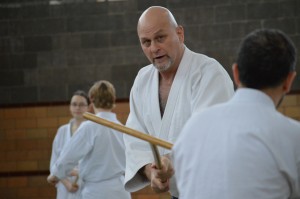 Although no longer a day-to-day practitioner of aikido, I have served as a technical advisor to several aikido dojo, developing a practice method that would lend itself to more effective atemi (striking methods), kaeshi-waza (counter-techniques) and the development of students’ abilities in more free-style practice, all of this without compromising the essential structure of classical aikido. My core concept is that all aikido techniques can be placed on five essential vectors of movement. This concept radically shortens the amount of time required for people to learn aikido. Counter-techniques, in particular, rather than something ‘pre-planned,’ based on the
Although no longer a day-to-day practitioner of aikido, I have served as a technical advisor to several aikido dojo, developing a practice method that would lend itself to more effective atemi (striking methods), kaeshi-waza (counter-techniques) and the development of students’ abilities in more free-style practice, all of this without compromising the essential structure of classical aikido. My core concept is that all aikido techniques can be placed on five essential vectors of movement. This concept radically shortens the amount of time required for people to learn aikido. Counter-techniques, in particular, rather than something ‘pre-planned,’ based on the  technique the opponent is attempting, become a natural unconscious response, as soon as the practitioner finds themselves ‘placed’ on one of those vectors.
technique the opponent is attempting, become a natural unconscious response, as soon as the practitioner finds themselves ‘placed’ on one of those vectors.
One of the most rewarding aspects of this project has been the opportunity to collaborate with a number of high level martial arts professionals who find aikido a martial art that provides a fascinating template for ‘open source’ study. Among them are:
- Budd Yuhasz who has adapted the principles I’ve established into both grappling and functional internal strength applications called Taikyoku Budo.
- Bruce Bookman, founder of Tenzan Aikido, with whom I’ve been developing a new set of jo forms that comprise the total of our 90+ total years of training. Our assumed task is to make a set of forms, each of which focuses on different specific principles of combat, each of which is a ‘reversible loop’ (tori and uke reverse at the end of the form and continue), all the while fostering principles specific to aikido.
